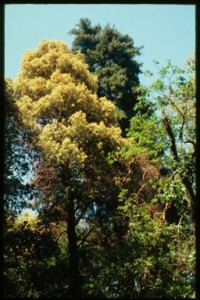Oregon authorities have announced that a dying tanoak detected by an aerial survey in the quarantine zone in Curry County, Oregon has proved to be in the EU1 clonal lineage. This is the first report of the EU1 lineage in North American forests. All other isolates of the causative pathogen Phytophthora ramorum in North American forests are the NA1 lineage. [See below for a discussion of P. ramorum clonal lineages.]
Dying tanoak (in California). Photo by F.T. Campbell
The infected tree is near a small private nursery that had been reported infested with the EU1 lineage of P. ramorum in 2012. The nursery carried out the APHIS-mandated Confirmed Nursery Protocol, then closed. Genetic testing suggests this nursery is the probable source population for the EU1infestation of the tree.This incident conveys several lessons:
- Discovery of the EU1 lineage of P. ramorum in the forest appears to confirm that nursery infestations can infect plants in the forest.
- The importance of genetic testing of samples from every infestation to determine which clonal lineage is present.
The discovery has troubling implications: The EU1 lineage consistently is a more aggressive pathogen than the NA1 clonal lineage already present in forests in California and Oregon. The EU1 lineage kills several types of conifer trees in Europe, including western hemlock (Tsuga heterophylla).
Furthermore, the EU1 lineage is of the opposite mating type as NA1, creating at least a small potential for sexual reproduction and increased variability in the pathogen population. (Sexual reproduction in P. ramorum can only occur when opposite mating types meet; in the absence if opposite mating types, all reproduction is clonal.)
The Oregon Department of Forestry is attempting to eradicate this small infestation. Host plants on the infested site have been cut and piled and will be burned as soon as wildfire risk abates. (Burning of other, lower priority sites has been delayed by inadequate funding). Authorities will also continue intensive surveys and will monitor soil and vegetation before and after treatment. Some funding for this work will come from the USDA Forest Service Forest Health Protection program and USDA-APHIS.
LINEAGES:
The Phytophthora ramorum pathogen is known to have four separate genetic lineages. The NA1lineage is the form of the pathogen established in forests of California and Oregon. This lineage is also the most common lineage in U.S. nurseries. However, two other genetic lineages are also found in U.S. nurseries: NA2 and EU1 (Coats and Chastagener 2009; Mascheretti et al. 2009). Indeed, NA2 was the most common lineage in Canadian nurseries (Goss et al. 2011).
The EU1 strain is widespread in European nurseries and in tree plantations and wild heathlands of southwest England, Wales, parts of Scotland, and Ireland. In 2012, a new, fourth strain was detected in Northern Ireland and a small area in southwest Scotland. This strain is called EU2.This strain is attacking larch, beech, fir, and hemlock trees at these sites (California Oak Mortality newsletter 2015).
Most EU1 and all EU2 type isolates belong to the A1 mating type, whereas the two North American strains belong primarily to the A2 mating type (Hansen et al. 2003). While P. ramorum apparently reproduces sexually only rarely, the presence of both mating types – in nurseries and especially in forests – does increase the possibility that sexual reproduction will occur. Sexual reproduction would allow the pathogen to evolve and perhaps become more aggressive.
NEW SITUATION:
The EU1 strain was detected in forest trees in Del Norte County, California in autumn 2020. This detection was both the first officially confirmed detection of P. ramorum in Del Norte County and the first detection of the EU1 strain in forest trees in California. The source is unclear. The nearest infestation is 12 miles away in Curry County, Oregon; those trees are infected with the NA1 strain. The nearest known EU1 infestation is about 35 miles away. The site of the California EU1 infestation has minimal California bay laurel (Umbellularia californica). This detection has led to designation of Del Norte County as officially infested; it becomes the 16th California county so designated. [Information from the California Oak Mortality Task Force newsletter for December 2020, available here.]
SOURCES
California Oak Mortality Task Force newsletter [http://www.suddenoakdeath.org/news-and-events/newsletter-archive/ ] April 2015.
Coats, K. and G. Chastagener. 2009. Understanding the mechanisms behind detections of Phytophthora ramorum in Washington State nurseries and streams utilizing microsatellite genotype information. Fourth Sudden Oak Death Science Symposium, June 15-18, Santa Cruz, CA.
Goss, E.M., M. Larsen, A. Vercauteren, S. Werres, K. Heungens, and N.J. Grünwald. 2011. Phytophthora ramorum in Canada: Evidence for Migration Within North America and from Europe. Phytopathology. January 2011, Volume 101, Number 1. Pages 166-171
Hansen, E.M., P.W. Reeser, W. Sutton, L.M. Winton, and N. Osterbauer. 2003. First Report of A1 Mating Type of Phytophthora ramorum in North America. Plant Disease, October 2003, Volume 87, Number 10. Page 1267.
Mascheretti, S., P.J.P. Croucher, M. Kozanitas, L. Baker, M. Garbelotto.2009.Genetic epidemiology of the Sudden Oak Death pathogen Phytophthora ramorum in Calif.Molecular Ecology 18: 4577-4590.
Posted by Faith T. Campbell
